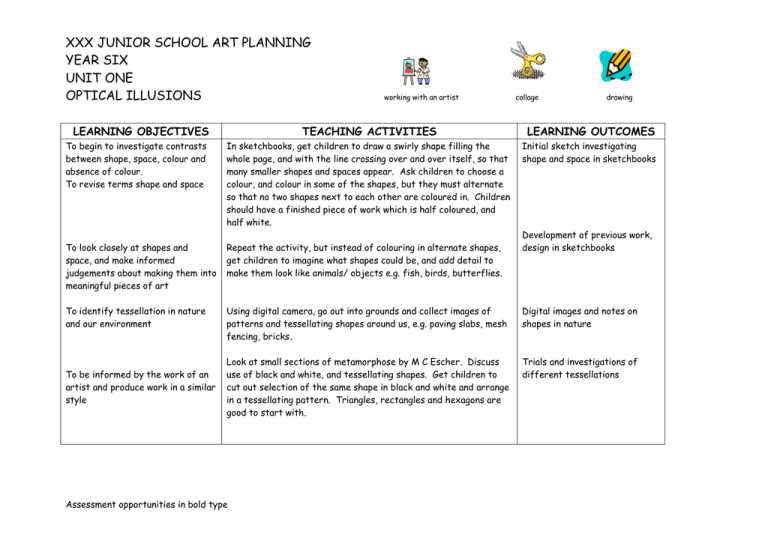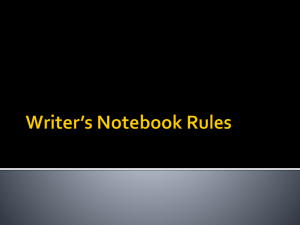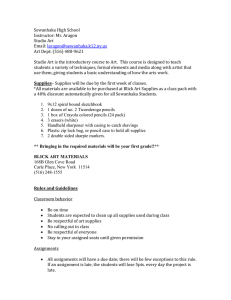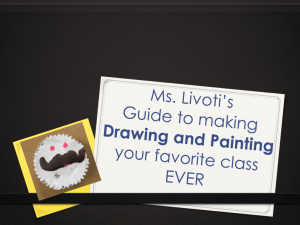XXX JUNIOR SCHOOL ART PLANNING YEAR SIX UNIT ONE OPTICAL ILLUSIONS
advertisement

XXX JUNIOR SCHOOL ART PLANNING YEAR SIX UNIT ONE OPTICAL ILLUSIONS LEARNING OBJECTIVES working with an artist collage drawing TEACHING ACTIVITIES LEARNING OUTCOMES To begin to investigate contrasts between shape, space, colour and absence of colour. To revise terms shape and space In sketchbooks, get children to draw a swirly shape filling the whole page, and with the line crossing over and over itself, so that many smaller shapes and spaces appear. Ask children to choose a colour, and colour in some of the shapes, but they must alternate so that no two shapes next to each other are coloured in. Children should have a finished piece of work which is half coloured, and half white. Initial sketch investigating shape and space in sketchbooks To look closely at shapes and space, and make informed judgements about making them into meaningful pieces of art Repeat the activity, but instead of colouring in alternate shapes, get children to imagine what shapes could be, and add detail to make them look like animals/ objects e.g. fish, birds, butterflies. To identify tessellation in nature and our environment Using digital camera, go out into grounds and collect images of patterns and tessellating shapes around us, e.g. paving slabs, mesh fencing, bricks. Digital images and notes on shapes in nature Look at small sections of metamorphose by M C Escher. Discuss use of black and white, and tessellating shapes. Get children to cut out selection of the same shape in black and white and arrange in a tessellating pattern. Triangles, rectangles and hexagons are good to start with. Trials and investigations of different tessellations To be informed by the work of an artist and produce work in a similar style Assessment opportunities in bold type Development of previous work, design in sketchbooks LEARNING OBJECTIVES TEACHING ACTIVITIES To be informed by the work of an artist and produce work in a similar style Take a 5 x 8cm rectangle of paper. To create a shape that will tessellate, anything that you cut from one side of the shape needs to be added to the opposite side. Cut out and stick on the opposite side pieces of the rectangle to make a simple shape, e.g. a fish, a rocket. Give children plenty of time to try out different shapes and check they tessellate so they can choose one final shape. Trials and investigations of different shapes To be informed by the work of an artist and produce work in a similar style Use template of final shape from last week to cut out 30-40 of chosen shape, half in black and half in white paper. Arrange in tessellating pattern and add detail using black and white colouring pencils. Final piece of tessellating work Give children the opportunity to discuss final piece with a partner. What do like about your work? What about your partner’s work? What would you do next time if you could do this work again? Notes in sketchbook To evaluate own work and that of others. To make critical judgements and suggest improvements Assessment opportunities in bold type LEARNING OUTCOMES XXX JUNIOR SCHOOL ART PLANNING YEAR SIX UNIT T L.S.LOWRY LEARNING OBJECTIVES working with an artist drawing TEACHING ACTIVITIES crayons and pastels ICT in art LEARNING OUTCOMES To use internet and other sources to find out information about Lowry. Look at selection of work by L S Lowry. Use internet to find out about his life. Try www.artchive.com and www.thelowry.com/lslowry.htm Also use bbc newsreel about L S Lowry painting robbery (4 th May 2007) to show children how valuable his work had become. (www.bbc.co.uk) Make notes and sketches about birth,death and names of some work. Brief notes and sketches to base future work on. To select a suitable area to work with, and reproduce carefully using observational skills Look at one Lowry painting in detail and choose a small area to reproduce (using a viewfinder) Use coloured pencils to create a drawing app 20cm squared in sketchbooks from what can be seen in viewfinder. 20cm square drawing of section of Lowry work To select a suitable area to work with, and reproduce carefully using observational skills Using drawing from last week, draw another 20cm square and sketch out the same area of drawing that was used as last week. Give children the opportunity to use a variety of materials, charcoal, crayon, oil or chalk pastel or sketching pastels to recreate the same drawing in a different medium. 20cm square section of Lowry work in chosen medium To select appropriate medium to work in To refine control of selected media compared to previous work Look at a copy of V.E. Day by Lowry. Discuss what can be seen and link into work on World War Two. Group children into groups of four and give them a large piece of neutral coloured sugar paper. Children need to outline sketch on large scale filling the whole paper. When enough detail had been added, fold and cut the paper into four. Each child can choose a medium to complete their quarter of the work. (2 weeks) Assessment opportunities in bold type Large scale collaborative work based on VE Day LEARNING OBJECTIVES TEACHING ACTIVITIES To critically evaluate own work and that of others. To use knowledge gained about artist to produce work in that style Put pieces of picture back together and take digital photos for children to stick in sketchbook. In sketchbooks, children can answer these questions: Why did you choose to use the materials you did? Are you happy with how it worked out? Why? In your sketchbook, use colouring pencils and sketching pencils to draw a picture called “The school Yard” in the style of L S Lowry. Assessment opportunities in bold type LEARNING OUTCOMES Notes and evaluation of own work. Small sketch in style of artist. XXX JUNIOR SCHOOL ART PLANNING YEAR SIX UNIT THREE PAPER MAKING LEARNING OBJECTIVES construction collage TEACHING ACTIVITIES LEARNING OUTCOMES To identify and collect colours in nature To revise terms tone and shade Go round woodland area and school grounds and collect a colour palette of natural colours. See if children can collect as many different colours as possible, then choose one colour and collect as many different shades and tones of that colour. Stick samples into sketchbook. Sample colour palettes in sketchbook To refine and develop skills of construction Collect as many different greens as possible from school grounds (leaves, grass, moss). Tear up kitchen roll into small pieces and add to a bowl of water with a small amount of PVA glue. Add greens that have been collected and stir until a pulp. Scoop out a handful and lay on a jay cloth on newspaper. Place another J Cloth over the top and press hard with a sponge to remove excess water. Leave to dry for 24 hours. Pieces of homemade paper incorporating natural materials Collect some more materials from outside, remembering to keep them small. Repeat activity from last week, but add torn tissue paper or food colouring to change type of paper made. (2 weeks) Pieces of homemade paper incorporating natural materials To alter way of working based on what has been previously learned. To investigate independently To be sensitive to materials and create a picture which shows understanding of the materials available Sketch out a simple shape on A4 paper of something in nature, a tree, a flower etc. Use the paper that has been made to collage over design. Swap paper with other people if necessary to get all the colours needed. Assessment opportunities in bold type Final piece combining paper already made LEARNING OBJECTIVES To understand the nature of the art work created and suggest appropriate uses for it TEACHING ACTIVITIES In a group discussion, or with your teacher, discuss where would be a good place to display your work and why. Ideas could be: in a school, in a library, in someone’s home. Assessment opportunities in bold type LEARNING OUTCOMES Notes in sketchbook XXX JUNIOR SCHOOL ART PLANNING YEAR ASSESSMENT Unit of work YEAR SIX UNIT ONE OPTICAL ILLUSIONS Assessment opportunities Give children the opportunity to discuss final piece with a partner. What do like about your work? What about your partner’s work? What would you do next time if you could do this work again? YEAR SIX UNIT TWO L S LOWRY Put pieces of picture back together and take digital photos for children to stick in sketchbook. In sketchbooks, children can answer these questions: Why did you choose to use the materials you did? Are you happy with how it worked out? Why? In your sketchbook, use colouring pencils and sketching pencils to draw a picture called “The school Yard” in the style of L S Lowry. In a group discussion, or with your teacher, discuss where would be a good place to display your work and why. Ideas could be: in a school, in a library, in someone’s home. YEAR SIX UNIT THREE PAPER MAKING OVERVIEW OF KEY SKILLS YEAR SIX UNIT ONE OPTICAL ILLUSIONS YEAR SIX UNIT TWO L S LOWRY YEAR SIX UNIT THREE PAPER MAKING CONCEPTS TALK ABOUT ART ,CRAFT AND DESIGN SKILLS AND PROCESSES LINE COLOUR FORM SHAPE SPACE LINE COLOUR TONE WORKING WITH AN ARTIST DRAWING IN A SKETCHBOOK COLLAGE THE PAST WORKING WITH ARTISTS COLOUR SHADE TONE FORM TEXTURE HERE AND NOW ENVIRONMENT DRAWING IN A SKETCHBOOK PASTELS AND CRAYONS LARGE SCALE WORK PENCILS COLLAGE CONSTRUCTION Assessment opportunities in bold type


